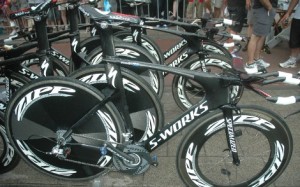
Racing isn’t usually the focus of this blog, but when July rolls around, I do get pretty excited about the Tour. This year’s race has been a great one so far, and I am already in the pattern of following some of each stage live in the morning, then scrambling to get my design work done as soon as the stage ends. That pattern makes for hectic days, but I just can’t wait until later to watch the replay. As I do most every year, I have been watching the live English language Eurosport feeds, which can be found at Steephill.tv. In addition to the video feed, I have been checking out the live blog discussion at Bicycling Magazine during the last couple stages. Honestly, I haven’t paid much attention to Bicycling Magazine in many years, but I really do like the way that they are covering the Tour this year. The commentary and discussion on the live blog and in their recent podcasts is pretty interesting, and I like the way that they are interacting with readers during each stage. I have been somewhat critical of the magazine in the past, but I really do want to give them kudos for what they are doing with their web coverage. Maybe, I should give the print edition of the mag a second chance too.
I am also checking CyclingNews, VeloNews, Road Bike Action, Pez , Bike198, and other cycling sites daily for race reports and, more importantly, tech features from the Tour. I won’t point out all the tech articles, but there are a couple so far that I want to mention.
I love time trial bikes, so RBA’s time trial tech pictorial caught my attention (still waiting on part 2 with more TT bikes and components from the Prologue). Speaking of the Prologue, check out the winning bike, Cancellara’s castrated SHIV (to borrow a term from the guys at the VeloCast in reference to the UCI required removal of the stem/steerer tube fairing).
CyclingNews points out some of the technology (or lack thereof when you consider the box section rims) used in yesterday’s stage. It is interesting to read about the various team’s different equipment choices for that stage with its seven rough cobble sections. I understand the desire of some teams to keep riders on the same bikes, but in retrospect Saxo Bank’s use of Roubaix SL3’s in place of the Tarmac SL3s (for a few select riders) certainly seems to have been a good decision.

Leave a Reply